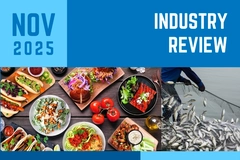
- Industry news
Industry news
- Category news
Category news
- Reports
- Key trends
- Multimedia
Multimedia
- Journal
- Events
- Suppliers
Suppliers
- Home
- Industry news
Industry news
- Category news
Category news
- Reports
- Key trends
- Multimedia
Multimedia
- Events
- Suppliers
Suppliers
BlueNalu and Nutreco collaboration accelerates global commercialization of cellular aquaculture

20 Jan 2020 --- BlueNalu, a California-based food company developing seafood products directly from fish cells, has announced a strategic partnership with Nutreco, a supplier of animal nutrition and aquafeed. Nutreco’s aquafeed company, Skretting, is a manufacturer and supplier of aquaculture feeds and an important link in the feed-to-food chain. The agreement builds upon BlueNalu’s platform technology for the production of cell-based seafood products from a wide variety of species. Moreover, the partnership is intended to create a more stable and sustainable supply-chain solution as the global demand for seafood is continually increasing.
Nutreco brings a breadth of knowledge and deep expertise to the partnership, including fish nutrition, raw materials expertise and ingredient procurement at competitive costs.

“We first started talking with Nutreco over one year ago, as we recognized early on that having an outstanding supply chain partner would be of great value to BlueNalu as we developed and implemented our commercialization and go-to-market strategy,” Lou Cooperhouse, President and CEO of BlueNalu tells FoodIngredientsFirst. “Partnering with Nutreco allows us to apply their deep knowledge of feeding fish, optimize our proprietary growth media for cell-based seafood products and secure a cost-efficient ingredient supply for the long-term.”
According to Cooperhouse, there are a lot of opportunities in the cell-based seafood space.
“Consumption of seafood is at an all-time high and is anticipated to grow significantly during the decades ahead, and our global supply simply cannot keep up with this demand,” he comments. Consumers enjoy so many different types of seafood species, including many varieties of finfish, crustaceans and mollusks. “The manufacture of seafood via our cellular aquaculture technology will allow us to supplement the wild-caught and farm-raised supply in a very sustainable way,” Cooperhouse notes.
In the cellular aquaculture process, each seafood species requires a tremendous amount of disciplined R&D and unique protocols, so there is much to be done, he adds. “At BlueNalu, we have developed a platform technology that we believe will allow us to produce any variety of finfish, whether saltwater or freshwater and without the use of genetic engineering. We have made tremendous progress in a short amount of time, as there were no reliable protocols available for establishing long-term muscle or fat cell lines from seafood species when we began. We recently demonstrated that we can produce yellowtail amberjack, that can be prepared in any form – raw, cooked and also acidified,” explains Cooperhouse.
BlueNalu is initially focusing on finfish that are overfished, difficult or impossible to farm raise, and are primarily imported to the US. “With our technology platform, we plan to continually develop new species of seafood products, so the opportunities are endless,” he continues. “We also recognize that we have much to accomplish as we work with regulatory agencies across the globe –and as we develop products and consumer communication strategies that are appropriate for each nation in which we go to market.”
“The growth media, utilized in growing our cells, is a crucial part of the cell-based industry, including seafood, poultry and meat products,” Dr. Chris Dammann, Chief Technical Officer of BlueNalu, tells FoodIngredientsFirst. “Ideally, media needs to be composed of natural ingredients and be serum-free and cost-efficient.”
While some growth media are commercially available, they are very expensive, contain animal-derived components, and are not applicable for growing fish cells, comments Dr. Dammann. BlueNalu has already made great progress in all areas and developed efficient media for several fish cell types, including animal component-free serum replacements.
“At the same time, we have reduced the price significantly,” he further notes. “This know-how and the resulting intellectual property portfolio are essential to enable large scale production. Despite these achievements, further innovation and optimization could improve performance and lower costs even more.”
“The partnership with Nutreco is another significant milestone for BlueNalu, which will enable us to accelerate our journey toward commercialization, while also securing a global supply chain partner. We expect this will provide significant value to our company, as it is our objective to introduce our seafood products in a test market during the next two years, and launch our products in several global markets by the end of this decade,” adds Cooperhouse.
The demand for protein, including seafood, will increase as the global population is expected to rise to almost 10 billion by 2050. Innovations and technologies, such as cell-based seafood, may be required to help to meet this demand in a sustainable manner. BlueNalu offers a third option that complements wild-caught and farm-raised seafood that benefits human health, encourages responsible food consumption and promotes food security.
“In ten years from now, we believe this sector will be under considerable growth, around the globe, as proof of commercialization and large-scale production will have occurred by that time,” Cooperhouse continues. “At that time, cell-based products will just start to become widespread, and available in foodservice and retail venues, with factories distributing a variety of cell-based seafood products globally. Consumers will find cell-based seafood products to offer a number of benefits, as they will be healthy for people, humane for sea life, and sustainable for our planet,” he concludes.
By Elizabeth Green











